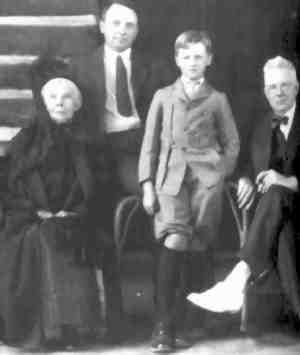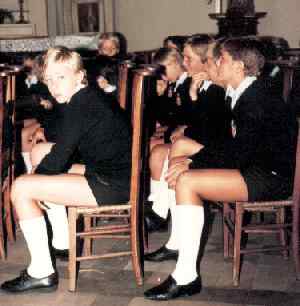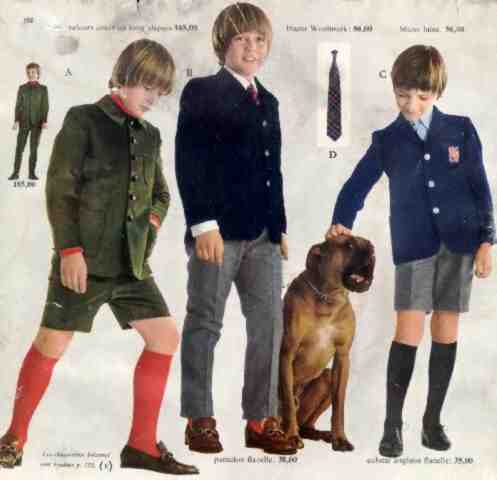Boys' Clothes: Major Fashion Trends

Figure 1.--Little boys in the 19th Century commonly wore dresses until
about 5 years of age, but this was up to the mother. Some mothers delayed
breeching for several more years. American boys in dresses generally wore
long dresses or stockings, French boys often wore short socks and strap
shoes.
|
Three basic fashions have swirled around boys's fashions since specialized childrens fashions first appeared in
the late 18thy Century. These issues were finally resolved in the period from 1920-60 as boys began to gain greater say over
the clothes she wore. The three major issues have been:
First: When should a boy be breeched and his curls cut?
Second: what type of collar should a boy wear, open or closed
and how fancy?
Third: Whether he should wear long or short pants?
The trends over time on these three basic questions were as follows:
Late 18th Century
Little boys in the late 18th Century continued to wear dresses like their mothers and sisters. Yjey
tended to be long dresses worn at ankle or shoe length. A new compfortable style of open collars developed.
While open the collars could be quite fancy ruffled ones. Boys like their fathers wore knee breeches and
skeleton suits appeared in the late 18th Century. After the beginning of the
French Revolution (1789), aristocratic fashions became less
dominate, especially in France. Proletatrian long pants became associated with the Revolution. Boys in particular
began wearing long pants with their skeleton suits, at a time when their well to do parents still wore knee
breeches.
Early 19th Century
Little boys continued to wear long dresses. As dresses became shorter, boys wore pantalettes
with them as bare knees even on children were considered inappropriate.
Open ruffled collars
continued to be worn, some quite prominate. Open collars were especially
popular for younger boys. Some fashions used high
closed collars. Bows were not much worn. Stiff white collars appeared
at Eton school. Boys after breeching might
wear tunics. Younger boys wore their tunics with pantalettes older boys
with long pants. No fashions involved bare knees--except for a small number of Scottish boys
wearing kilts.
Mid-19th Century
Dresses and curls
Little boys continued to wear dresses little fifferent than their sisters.
Shorter dresses became common. At first boys and girls wore pantalettes
to cover their legs. This began to change in the 1850s. I think one of
the reasons for this was the kilt popularized by Queen Victoria for the
princes. This was the first garment in which boys knees were allowed to
appear. Apparently this made it possible for young children to wear
their dresses with bare knees. Pantalettes were still worn, but now
usually only to the hem of a boy'd dress, not below it.
While many little boys wore dresses, hair styles were less uniform.
Many boys were kept in long, mostly unstyled curls. Other boys had their
hair cut boyishly short while still in dresses. Short hair was
particularly common after breeching. Most boys after when
graduating to tunics and pants wore their hair short.
Collars
Boys wore closed collars at mid-century. Mostly collars were plain and
often quite small. They were often worn with small bow ties. Older boys were
increasingly wearing Eton collars, usually without ties.
Pants
Most boys wore long pants. Tunics passed out of style. Majorr new styles for boys were
introduced for boys in the 1840s when Queen Victoria began dressing the
princes in kilts. This was the first garment for boys that involved bare knees.
Kilts were being worn by Scottish boys, but the Queen's choice popularized
kilts in England, America, and even Europe.
Other styles for boys involved
mostly long pants. Queen Victoria also popularized the sailor suit for boys
and the early ones were worn with long pants--often the bell bottom
trousers worn by British sailors.

Figure 2.--The sailor suit was one of the most popular styles for boys.
In the 19th century American boys most commonly wore kneepants and long
stockings.
|
Modern looking suits began to appear. The blazer which first appeared in 183?
when the captain of the HMS Blazer decided to smarten up his seamen had
by mid-century began to appear more commonly in civilian atire. Boys
mostly wore their suits with long pants. Some boys wore knickers blouced
at the knee. Some boys began to appear in kneepants, but until the 1870s the
dominate style was long pants.
Late 19th Century
Dresses and curls
Little boys continued to be outfitted in dresses. Special dresses
specifically for boys appeared which were somewhat less elabotately
styles. Some mothers, however, preferred the fancier styles for girls.
Other mothers hesitated to breech their sons chose the popular kilt
suits. Mostly boys were breeched about 5 years of age, but this varied
at the mothers disgression and much older boys sometimes wore dresses.
Younger boys in dresses might wear short dresses and bare knees.
Pantalettes were still worn but became much less common in the 1880s.
Bare knees other than for younger boys in dresses were rare. Older
French boys kept in dresses might have barevknees, but
this was not common in Britain and America. English boys wearing
Scottish-style
kilts might have bare knees, but American boys in kilt suits always wore
long stockings and not plaid kneesocks.
boyswere

Figure 3.--Boys in the late 19th Century commonly wore Little Lord Fauntleroy
suits with large lace collars and bows with knee pants and long
stockings.
|
Long hair became much more common than earlier. Some mothers styled
their sons hair into long ringle curls. Some boys had their hair cut
before breeching. Other boys wore long hair until 11 or 12 years of age,
depending on their mothers' preferences.
Collars
The late 19th Century was the era of the collar. Boys might wear huge
lace and ruffled collars, sometimes spilling over their shoulders. They
were worn with large bows of various colors and patterns. Stiff Eton
collars became the syandard for older boys.
Pants
Boys in the late 19th Century wore kneepants, mostly with long stockings.
At first in the 1860s and 1870s it was mostly younger boys. By the end of
the century, however, quite old boys wore kneepants although this
varied more than for younger boys. Boys wore kneepants with most styles,
velvet Little Lord Fauntleroy suits, sailor suits, Norfolk suits
and others.
Some boys wore their sailor suits with lonf pants, but kneepants were most
common. Kneepants were mostly worn with long dark stiockings. Some boys
might wear kneepants without shoes and stockings in the summer--especially
in the South. Boys did not, however, wear above the knee pants. The
kneepants style was the most common, but boys also wore knickers blouced
at the knee. This knickers style was more common in England than
America.
Early 20th Century
Dresses and curls
The first of the three major issues of boys fashions was settled in
the early 20th Century. Little boys in the first decade of the
20th Century were still outfitted
in dresses, but this became less common in the 1910s and for all
practical purposes, except for very little boys, disappeared in the 1920s.
Thus after centuries of dressing small boys like their sisters, it was
decided that boys--event little boys would from now own be dresses in
distinctly boyish styles. While by mid-century girls were allowed to
wear boyish styles it became absolutely unfashionable for boys to wear
anything that looked remotely like a girlish style.
The same fate awaited long hair for boys. After the first
decade, long ringlet curls became much less common,
although little boys still commonly had long hair. Most boys in the new
Century wanted short hair like their fathers. Short hair cuts were common
for boys of 5 or 6 years by the 1920s. This continued until the 1970s when
long hair reappeared. However, this time it was the boys who wanted their hair long
and the parents who wanted short hair. Fashion at times is difficult to
fathom.
Collars
Lace collars became less common after the turn of the century, although
large ruffled collars were still worn in the early 1920s. The Fauntleroy
after the turn of the century were more commnly worn with open ruffled
collars. Little boys might wear Peter Pan collars, but by the 1930s the second
basic issue of boys' clothes was settled. Boys except for very little chaps would no longer
wear large, fancy collars. Instead they would wear what ever their fathers
wore, be it straight or button downed.

Figure 4.--Many American mothers wanted their sons to wear their
knickers above the knee. As kneesocks were replacing long stockings this
meant that boys would have bareknees even though they were wearing knickers..
|
Pants
The issue of pants continued unresolved in the first several decades
of the 20th Cetury. Kneepants generally disappeared after the first
decade. Some boys wore long pants, but most boys even older boys
wore knickers or the developing new style of short pants with bare knees.
With the exception of little boys in dresses, boys for centuries had
covered their knees. Boys in the 19th Century had covered them with
long pants, pantalettes, or stockings--but bares knees were rarely seen on
older boys unless wearing the kilt. Styles and conventions in the
early 20th Century varied greatly from country to country. British boys
of all ages wore shorts. Some schools insisted on shorts for even older
teenagers. British boys wore shorts with kneesocks all year round. Many
French and German boys also wore shorts, but it was not required by schools which did not
generally have uniforms. Some parents insisted on shorts throughout the
year, but many allowed longpants during the winter. Short pants were not popular
in Americsa fo older boys. Many did not like the idea of bare knees. Rather
American boys wore knickers.
Mid-20th Century
Dresses and curls
Collars

Figure 5.--Boys in the 20th Century have worn short pants of every
conceveable length. The French schoolboys wear short cut short pants
as part of their school uniform.
|
Pants
The issue of pants was in a state of flux during the mid-19th Century
and styles varied substantially from country to country. British and
European boys, even older boys commonly wore short pants and kneesocks.
Thiswas especially true in England as many schools had uniforms
requiring short pants. Some private secondary schools eve required older boys to ear
them. Mosy boys by the 1960s wanted to wear long pants. Only little
boys, with some exception wore shorts. The genera trend was the declining
use of short pants with suits. American boys in the 1960s began to wear
shorts as casual wear.
Late 20th Century
Dresses and curls
Collars

Figure 6.--French boys generally wore short pants suits in first
part of the 20th Century, but by the 1970s long pants suits had become more
common.
|
Pants
The 21st Century
Christopher Wagner
histclo@lycosmail.com
Navigate the Historic Boys' Clothing Web Site:
[Return to the Main essay page]
[Introduction]
[Chronologies]
[Style Index]
[Biographies]
[Bibliographies]
[Activities]
[Countries]
[Contributions]
[Boys' Clothing Home]
Navigate the H istoric Boys' Chronology pages:
[Return to the Main chronolgy page]
[Late 18th Century]
[The 1800s]
[The 1810s]
[The 1820s]
[The 1830s]
[The 1840s]
[The 1850s]
[The 1860s]
[The 1870s]
[The 1880s]
[The 1890s]
Navigate the Historic Boys' Clothing Web style pages:
[Short pants suits]
[Blazers]
[Lace collars
[Fauntleroy suits]
[Sailor suits]
[Ring bearer/page costumes]
[First Communion suits]
Created: November 3, 1998
Last updated: July 23, 1999





